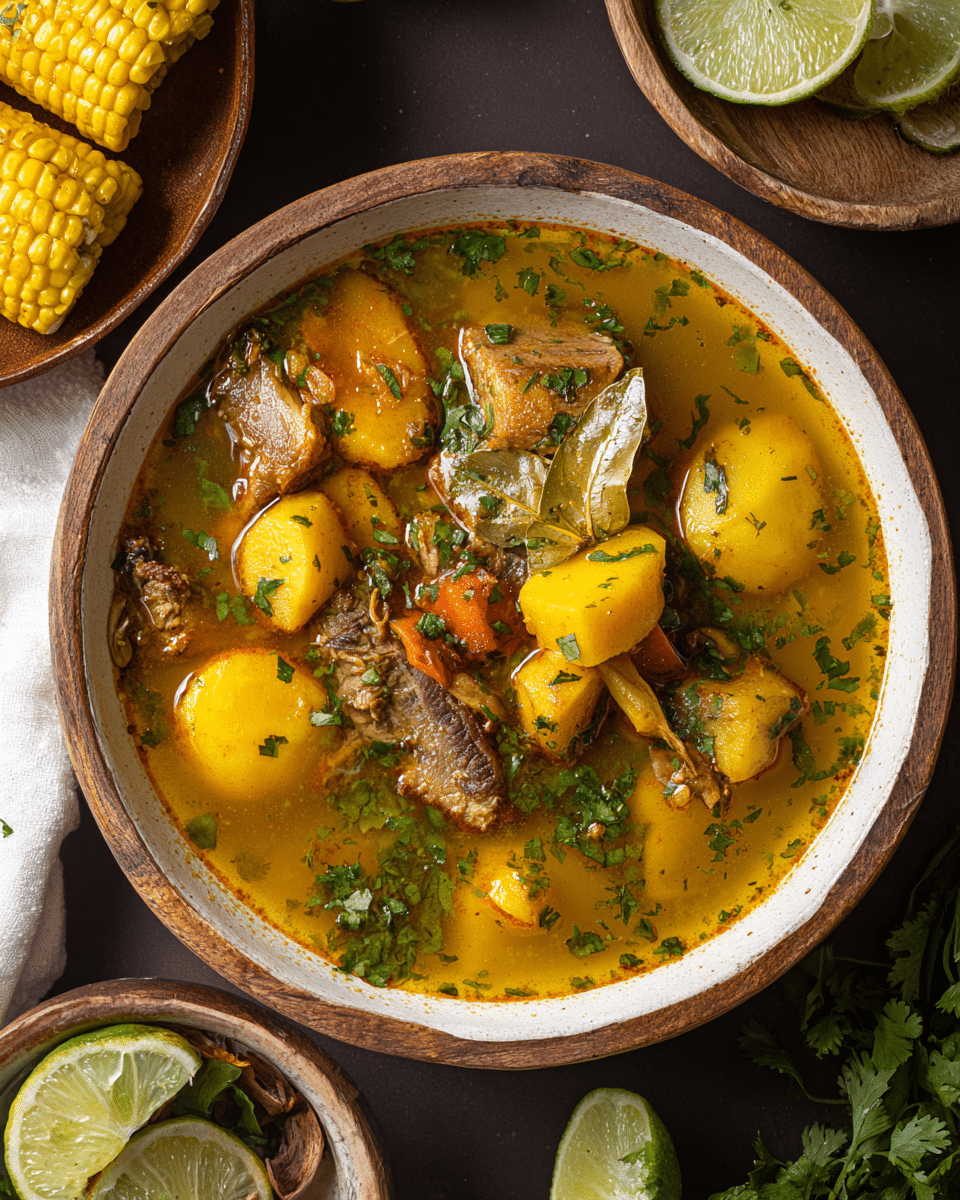This Dominican Sancocho is the soul of the Caribbean in a bowl. Made with a rich mix of meats and hearty root vegetables, it’s the kind of meal that warms your belly and your spirit. Each spoonful carries layers of flavor, from slow-cooked beef and chicken to the earthy richness of yautía, yuca, and plantains.
Traditionally served at gatherings and family events, Sancocho is more than just a dish — it’s a celebration of Dominican culture and community. It’s the kind of meal that brings people together around the table, sharing stories, laughter, and good food. Whether you’re Dominican or just looking to explore Caribbean cuisine, this is a dish that deserves a place in your kitchen.
Full Recipe
Ingredients:
-
1 ½ lbs beef chuck (bone-in), cut into chunks
-
1 lb pork ribs, cut into small pieces
-
1 lb chicken thighs or drumsticks
-
½ lb smoked pork sausage, sliced
-
½ lb pork belly or salted pork
-
½ lb goat meat (optional)
-
½ lb pork trotters or cow feet (optional)
-
2 green plantains, peeled and sliced
-
2 yuca (cassava) roots, peeled and chopped
-
2 yautía (taro or malanga), peeled and chopped
-
2 corn on the cob, cut into chunks
-
1 large sweet potato, peeled and cubed
-
1 small pumpkin or squash, peeled and cubed
-
1 red bell pepper, chopped
-
1 green bell pepper, chopped
-
1 onion, chopped
-
4 cloves garlic, minced
-
1 bunch cilantro, chopped
-
2 limes (for cleaning meat)
-
1 tsp oregano
-
1 tsp ground black pepper
-
2 tbsp oil
-
2 cubes chicken or beef bouillon (optional)
-
10 cups water
-
Salt to tast
Directions:
-
Clean all meats with lime juice and rinse thoroughly. Pat dry and season with garlic, oregano, black pepper, and a bit of salt. Let it marinate for at least 1 hour, or overnight for better flavor.
-
In a large pot, heat oil over medium heat. Add beef chunks and brown for about 5-7 minutes. Gradually add the remaining meats, searing each for color and flavor.
-
Add onions, bell peppers, bouillon cubes (if using), and water. Bring to a boil, reduce heat, and simmer for about 45 minutes to 1 hour, until meats begin to tenderize.
-
Add root vegetables (yuca, yautía, sweet potato, pumpkin) and corn. Let simmer for another 30 minutes, stirring occasionally to avoid sticking.
-
Add green plantains and continue to cook until all vegetables are soft and stew is thickened. Taste and adjust salt as needed.
-
Stir in chopped cilantro and let simmer for an additional 5 minutes before serving.
-
Serve hot with white rice and avocado on the side, if desired.
Prep Time: 30 minutes | Cooking Time: 2 hours | Total Time: 2 hours 30 minutes
Kcal: 550 kcal | Servings: 8 servings
The Cultural Roots of Dominican Sancocho
Dominican Sancocho is more than a meal—it’s a legacy. Deeply rooted in the Dominican Republic’s rich culinary and cultural history, this traditional stew has become a national symbol of family, unity, and comfort. Passed down through generations, Sancocho is commonly prepared for holidays, large family gatherings, and especially on rainy or cold days when its hearty warmth is most appreciated.
What makes Sancocho uniquely Dominican is its bold use of multiple meats—often seven in a single pot—paired with a diverse array of root vegetables native to the Caribbean. Each region and even each family has its own variation, but the heart of the dish remains the same: deep, layered flavors built slowly with care and tradition. In essence, Sancocho represents the Dominican spirit—resilient, diverse, and always ready to bring people together.
The Origins of Sancocho in the Caribbean
Sancocho finds its origins in the Canary Islands and Spain, but it evolved significantly in the Caribbean. As Spanish colonists arrived in Hispaniola (modern-day Dominican Republic and Haiti), they brought culinary traditions that merged with those of the Taíno indigenous people and African cultures. Over time, this fusion of cooking techniques and ingredients created a unique stew, customized to the abundant produce and livestock of the tropical climate.
In the Dominican Republic, Sancocho evolved to feature native ingredients like yuca (cassava), yautía (taro), plantains, and auyama (Caribbean pumpkin). The use of multiple meats—beef, pork, chicken, and sometimes goat—reflects both resourcefulness and generosity. A true Dominican Sancocho isn’t complete without this medley of proteins, each contributing its own flavor and richness to the final dish.
Why Sancocho is Considered a Celebration Dish
Sancocho is synonymous with celebration. While it can be made in smaller quantities for a regular meal, it’s typically served at large events, holidays like Christmas, or during Dominican Independence Day. Preparing a large pot of Sancocho is often a community event, with multiple people helping to peel vegetables, season meats, and keep the fire going if it’s cooked outdoors over charcoal or wood.
In many Dominican households, Sancocho is also seen as a remedy or restorative food—great for recuperation after a long night or even for “el día después” (the day after) a party or special event. Its richness and nutritional density make it perfect for refueling the body, which is why you’ll often see it at major social events, family reunions, and festivals.
Key Components That Make It Special
Sancocho is a stew that embraces complexity. Its base starts with a blend of meats, typically a combination of chicken, beef, pork, and sometimes goat. The meats are often marinated with citrus, garlic, oregano, and other spices, giving the dish its unmistakable depth of flavor.
Root vegetables are another defining feature. Yuca and yautía bring a starchy texture, while plantains add subtle sweetness. Corn on the cob, auyama, and potatoes are common additions that contribute both flavor and visual appeal. These ingredients simmer together until the broth thickens slightly, creating a rich, velvety soup that clings to the spoon.
Herbs like cilantro, culantro (if available), and green peppers balance out the heaviness with a touch of freshness. And while the spices aren’t overly hot, Sancocho is boldly seasoned, emphasizing flavor over fire.
Regional and Family Variations
Like many national dishes, Sancocho varies from region to region and even from one family to another. In the Cibao region of the Dominican Republic, goat meat is a common addition, adding a gamey richness that elevates the flavor profile. Coastal areas might lean more toward seafood-based sancochos, though this is less traditional.
Some households keep their Sancocho simple with just three types of meat, while others go all out with seven—creating what’s known as “Sancocho de Siete Carnes” or seven-meat sancocho. While seven meats might sound excessive, in Dominican culture, it signifies abundance, hospitality, and respect for guests.
Vegetarian versions are rare but possible, substituting meats with beans and expanding the selection of vegetables. However, for purists, true Dominican Sancocho must have a robust combination of meats.
Nutritional Value and Comfort Factor
Despite its rich ingredients, Sancocho is surprisingly balanced in nutritional content. The root vegetables provide essential fiber and complex carbohydrates, making it highly filling and energizing. The meats offer protein, iron, and minerals, while the spices and herbs bring antioxidant and anti-inflammatory benefits.
But more than physical nourishment, Sancocho delivers comfort. It’s the kind of dish that soothes your soul, warms your body, and evokes feelings of nostalgia. For many Dominicans, Sancocho brings memories of their abuelita (grandmother), special occasions, or rainy days at home.
Sancocho as a Symbol of Dominican Identity
Food is one of the most powerful expressions of culture, and Dominican Sancocho is no exception. It embodies the multicultural roots of the island—indigenous, African, and European influences all stewed together in harmony. It’s a culinary metaphor for Dominican identity: diverse, rich, and full of life.
When Dominicans abroad prepare Sancocho, it’s not just about satisfying hunger—it’s about reconnecting with their roots. It’s a form of cultural preservation, a way to carry home in their hearts and kitchens, no matter where they live.
Even among non-Dominicans, the dish has gained popularity for its complex flavors and comforting qualities. Restaurants in New York, Miami, and other cities with large Dominican populations often feature Sancocho on their menu, showcasing its role as an ambassador of Dominican cuisine to the world.
Pairings and How to Serve Sancocho
Sancocho is most commonly served with a bowl of white rice on the side. The rice helps absorb the flavorful broth and balances the richness of the stew. Many also enjoy it with slices of ripe avocado and a few drops of lime juice for brightness.
Some households serve it with a side of tostones (fried green plantains) or arepas (cornmeal cakes), especially in rural areas. A chilled glass of natural fruit juice—like passion fruit, tamarind, or guava—completes the meal beautifully.
While it’s traditionally a lunch or midday meal due to its heaviness, Sancocho can also serve as a hearty dinner, especially on weekends or during festive seasons.
Cooking Sancocho: A Labor of Love
Sancocho is not a dish you rush. It’s a culinary ritual that takes time, patience, and care. The meats must be browned properly, the vegetables peeled and chopped thoughtfully, and the flavors layered slowly over heat.
Many Dominican cooks pride themselves on their Sancocho recipes, tweaking seasoning and timing to achieve perfection. And while it can be cooked on a stovetop, some say it tastes best when made outdoors over a wood fire, giving it a rustic, smoky depth that modern kitchens can’t replicate.
Making Sancocho is an act of love—an offering to those you care about. Whether for a special occasion or just a regular Sunday meal, it carries the unmistakable message: “You are welcome here.”
Conclusion: A Dish That Tells a Story
Dominican Sancocho is far more than a traditional stew; it’s a culinary treasure and a cultural icon. Rich in history, ingredients, and meaning, it bridges generations and brings families and communities together. Its depth of flavor mirrors the complexity of Dominican identity, and every bite tells a story of resilience, hospitality, and shared joy.
In a world where fast food and fleeting trends dominate, Sancocho stands out as a reminder of the value of slow-cooked, heart-filled meals. It invites us to gather around the table, to share, to celebrate, and to remember where we come from. And that’s the true magic of Dominican Sancocho.






